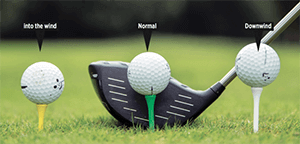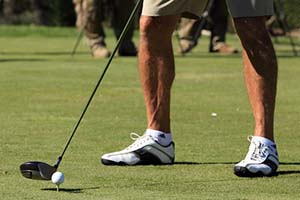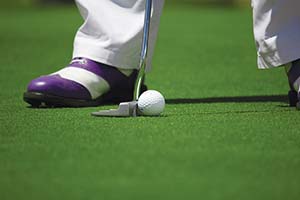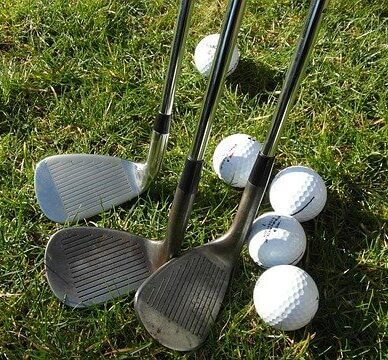1. ‘EVALUATE’ the wind’s ‘Direction and Velocity’ remembering that these change significantly with height above the ground and when trees and other factors are present.
2. ‘VISUALIZE’ the ‘Ball Flight’ or ‘Shot Pattern’.
3. ‘KEEP UNDER THE WIND’. Logically, if there were no wind or less wind, you could do less to compensate for it. There is generally less of it closest to the ground (‘Shift & Veer’). More simply put, the closer you are to the ground, the less time and margin there is for error to take place. Putts are less effected by the wind than are ‘Drives’.
4. ‘CLUB SELECTION’ during your ‘Pre-Shot Routine’ is always important. Still the case! You want lower ‘Trajectory’ so as to ‘Stay Under The Wind’ therefore select less loft. The smaller the number on the ‘Clubhead’ the ‘Less The Loft’ and the longer the shaft. This means that your ‘Clubhead Speed’ will be greater with perhaps less effort. So farther and lower can result from proper ‘Club Selection’. Generally “Take More Club” with ‘Head or Cross Winds’ and less with ‘Tail Winds’. When you ‘Feed The Ball’ up into the ‘Tail-Wind’, it gets a bigger ride!
5. ‘STANCE’ is key. ‘Stand For Stability’ as always. You may ‘Pre-Select a slightly wider ‘STANCE Component’ to counteract the force of the wind on your body. Don’t just widen without cause. You must still ‘Steer So You Can Clear’ as the ‘Procedure’ you have selected is likely a ‘Full Swing’ or ‘Stage Three’. Watch your ‘Target Foot’. You must ‘Rotate’!
6. ‘BALL LOCATION’ is important. Our identified desire is to ‘Keep The Ball Below The Wind’ so less loft is vital. To produce reduced ‘Net Effective Loft’ move the ‘Ball Location’ slightly aft of what would be your normal station.
7. ‘ABBREVIATED SWING LENGTH’ is beneficial. The longer the ‘Swing’ the higher your ‘Hands’ will get above your ‘Head and Shoulders’; higher into the wind and more exposed. Also you are ‘Less Balance and Less Stable’ when your ‘Hands’ are high. You have your ‘4 B’s’ that help produce your ‘Swing’. If you say “Brace Hand Brace Shoulder”, you will generally abbreviate slightly. ‘Feel It’. If you must shorten further, think ‘Punch Shot or Action’ and start ‘BODY CLOCKING’.
8. ‘The Ball Goes Where Your Hands Go’ is key.
9. ‘ALIGNMENT’ is key. Always set your ‘5 Axes’ to accomplish your most natural ‘Swing’ ‘Down The Body Line’.
10. ‘FEED THE WIND’ is key. Rather the opposite to ‘Keeping Under The Wind’. Always make straight, ‘Low Side Spin Rate’ shots first. If you can master the ‘Straight Shot’ you can bring most every golf course to its knees! This in mind for wind play, once you have determined item #1 above, ‘Velocity and Direction’, strike the Ball to the upwind side of the Target and allow the wind to carry it back to ‘Target Line’ or selected ‘Ball Flight Line’. This will take care of your ‘Cross Wind Component’. The greater the ‘Velocity’ the more the ‘Upwind Aiming Component’ will be. With no ‘Cross Wind Component’, all you have to do is determine the ‘Up or Down Wind Component’ and plan accordingly. Send the ‘Ball’ ‘High For Downwind’ and ‘Low for Upwind’. You ‘Feed the Ball to the Down Wind’ and ‘Fight the Upwind’ by ‘Hiding From It’ or, again, ‘Staying Under It’. Remember, a ‘Golf Ball’ with a ‘Tail Wind Component’ (Downwind) will NOT stop readily. Approach shots ‘Downwind’ will NOT bite and hold as well as those that are ‘Into or Upwind’. Factor ‘Run or Roll’ to score well. Airplane pilots should have this wired!
11. ‘CUT INTO THE WIND’ is a second ‘Direction’ choice. You can either ‘Draw, Hook or Fade, Slice Your Golf Ball Into The Cross Wind To Hold Your Pre-Selected Ball Flight Line’. Decide! You can ‘Draw or Fade’ in one of two ways. You can ‘Align To Draw or Fade’. You can also ‘Adjust Your ‘Clubface AIM’ To Draw or Fade’ and make the same ‘Natural Swing’. To ‘Hook or Slice’ you will likely adjust your ‘STANCE and/or ALIGNMENT’ ever so slightly. Both are ‘SET-UP’ (Passive or Static) compensations and NOT ‘Swing Changes’ (Active or Dynamic). You must always ‘Swing Down Your Body or Foot Line’. The stronger the ‘Cross Wind Component’ the more ‘SETUP Component Change’ you will require. As stated, if the ‘Cross Wind Component’ is really brutal, you may have to ‘Hook or Slice’ to compensate. Don’t put up your umbrella!
12. ‘SWING MORE SMOOTHLY’. Do not try to overpower the wind. That will not work.
13. ‘Dress Appropriately’. Comfort is key.
14. ‘Be Patient’. Remember, everyone is in it with you! The lowest numbers still win, even if they are higher.
15. ‘Play A to B Golf’ first. Then utilize ‘Spin Rate’ to offset the ‘Direction and Velocity’ of the wind. ‘Work Smart!’ ‘Manage your Game’! Then it will not run you!
16. ‘Take A Nice Deep Breath And Relax’ in the wind.
17. ‘Be Confident’
18. ‘PORTA-POTTIES’ blowing over, ‘Stay Out and Go Home’!
All this ‘Wind Stuff’ makes me feel a bit like a sailor! Play well!


















